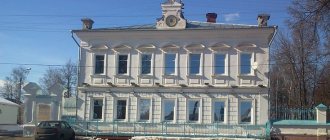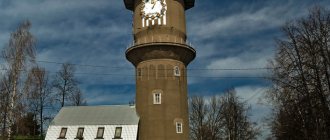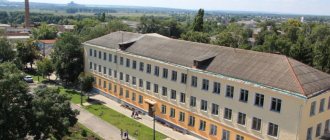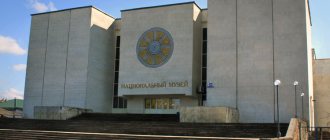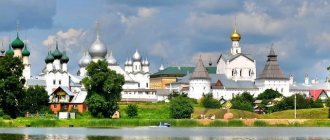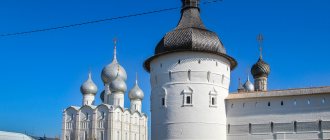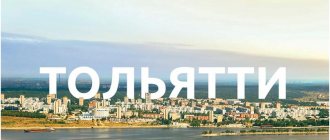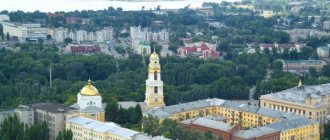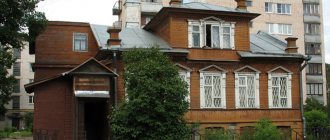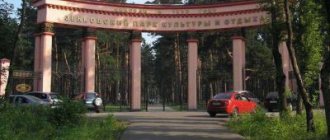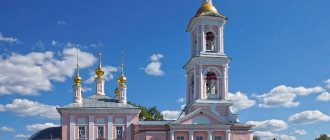Shebekinsky Historical and Art Museum
Founded on November 6, 1986, the museum is currently located on Lenin Street 93. All exhibition material of the museum is presented in 5 exhibition halls. The exposition of each hall of the museum reflects the history and culture of the Shebekinsky district.
The museum's collection is represented by the following exhibits: Scythian household items and weapons, primitive tools of the Saltovo-Mayak culture, ancient money, pre-revolutionary photographs, famous paintings, etc., in total the museum stores about forty thousand items. In general, after visiting this museum, a tourist or just a visitor to the city will not be disappointed.
Former office of the Shebekinsky sugar factory
At the intersection of Lenin and Moskovskovskaya streets there are several very remarkable buildings. One of them is the former office building of General Rehbinder, which was built at the beginning of the 20th century. This is a fairly typical building of late 19th century architectural style and is a two-story brick building that housed the plant's management staff. Today the building has been preserved in its original form.
The building of a former two-class school
School No. 3 is located on Oktyabrskaya Street; what is remarkable about it is the fact that one of its buildings is a preserved building, the house of General Rehbinder’s daughter. In its original form, the house consisted of three parts: the buildings were one-story at the edges, and two-story in the center.
At the beginning of the 20th century, the house was converted into a two-class school, with a school canteen, a gym and workshops. Both boys and girls could study at the school, and they taught a variety of subjects from aesthetics to foreign languages. Only the central two-story building has survived to this day, which, as mentioned above, is the school building.
New in blogs
I read an article in SR NEZHEGOL STILL REMEMBERS, what kind of people’s power we have lost , the name of the city of Shebekino seemed unusually familiar.
I plunged into the depths of the Internet and found so many interesting things that I decided to share with you, my friends.
In 1654, on the site of a suburb of modern Shebekino, the fortress city of Nezhegolsk was built, which was part of the Belgorod defensive line. The Belgorod defensive line for a long time was the southern border of the Russian state, on which the Crimean Tatars from the south and the Polish-Lithuanian troops from the west were holding out.
The date of origin of Shebekino is considered to be 1713, when it was first marked on Russian maps. The settlement received its name from the surname of the first landowner, who settled his serfs here and founded the village. Lieutenant Colonel Ivan Dmitrievich Shibeko, who was one of the participants in the Battle of Poltava, bought 160 quarters of land from the nobleman N.R. Maslova. He settled his peasants on the right bank of the Nezhegol River. On his estate, in addition to the estate, he also built a mill.
A.V. Makarov (1675-1750)
In 1716 I.D. Shibeko and his wife died without leaving children. The entire estate passed into rental ownership to Alexei Vasilyevich Makarov, the former cabinet secretary of Peter I. He constantly accompanied Peter I on trips. Having great influence on the course of government affairs, Makarov made a brilliant career. For his assistance in the enthronement of Catherine I, he was awarded the rank of Privy Councilor and large estates. During the reign of Catherine I, Alexey Vasilyevich enjoyed great authority and influence. He took an active part in the work of the Supreme Privy Council. In 1723 he bought from V.V. Titov and Titovka* with a cloth factory there. At that time there were 1 master and 3 workers working at this plant. Subsequently, Titovka belonged to Makarov’s granddaughter, who married Lieutenant Colonel Mikhail Ivanovich Batezatul. After the death of A.V. Makarova Sloboda Shibekina became the object of many disputes. Its owners changed several times. In 1785, the settlement of Shibekina (later Shebekina) came into the possession of Ekaterina Petrovna Baryatinskaya (1750-1811)
General of Infantry Alexander Alekseevich Rebinder (1826-1913)
Since 1836, Shebekino was the family estate of the Rebinders. This family had a great influence on the development of the Shebekina settlement. Industry began to develop in the settlement from the middle of the 19th century, when in 1839 the owner of the settlement, Alexey Maksimovich Rebinder, built a primitive sugar factory on the banks of the Nezhegol River, which was reconstructed and enlarged in 1848. The plant was named Alekseevsky (named after its owner). In 1847, a brick factory was built, which was intended to provide the enterprise with building materials. In 1850 General Rebinder's beet sugar factory has already become one of the best in the Kursk province. In 1867, Alexander Alekseevich Rebinder (son of A.M. Rebinder) built mechanical workshops for the repair of agricultural equipment. In 1875, he also built a distillery and a two-story mill with a butter churner. In 1888, the sugar factory was reconstructed. The main and two side buildings were built. A water pump has been installed. Shebekinsky and N-Tavolzhansky sugar factories already in 1890 produced products worth 1,575 thousand rubles. Such an increase in product volumes dictated the need to resolve the issue of simplifying the methods of its removal from the plant for delivery to customers. In 1896, the construction of the railway line from Belgorod to Kupyansk was completed, on which the Nezhegol passenger station appeared. From it, access railway tracks were made to the Botkino freight station in N-Tavolzhanka and to the Rebinderovo freight station in the Shebekino settlement.
The use of the latest machinery at the sugar factory, as well as the use of new methods of field cultivation and agricultural technology in growing sugar beets, created a need for educated and skilled workers. Therefore, Alexander Alekseevich, together with his brother Nikolai, founded an agricultural school for workers for 120 people in Shebekino in 1875. It accepted students at least 14 years old, who were taught by 3 teachers. They were trained in field work, carpentry and plumbing. This institution was closed and was completely dependent on its founders. Since 1892, Alexander Alekseevich Rebinder became the trustee of this school, which became known as the Maryinsk Lower Agricultural School of the 1st category.
Baron N.A. Rebinder (1863-1918)
Baron A.A. Rebinder (1869-1918)
Shebekinsky sugar factory 1908 Power plant
Mechanical workshops 1913
At the beginning of the 20th century, the existing Shebekinsky industrial enterprises expanded significantly and new ones appeared.
In 1905, A.A. Rebinder built a power plant at a sugar factory, which provided electricity not only to sugar and other enterprises, but also to residential buildings. In 1907, a steam locomotive was purchased from Berlin for the sugar factory. In 1909, the sugar factory was reconstructed. Daily sugar production amounted to 15 wagons of 900 poods each. The income received from the sugar factory in 1915 increased from 2 to 3 million rubles per year. The Alekseevsky / Shebekinsky / sugar factory became the largest in Russia and was equipped with the best equipment at that time. In 1914, A. Rebinder built a tannery and a slaughterhouse. Until 1917, 1,385 permanent workers worked at the tannery and sugar factories.
Before the revolution, in the Shebekino settlement, in addition to sugar and leather factories, there were alcohol, chalk and brick factories, as well as agricultural workshops.
Family coat of arms of the Rebinders. House of A.A. Rebindera
In the post-war years, the city of Shebekino developed very quickly as a city of chemists. Construction of the chemical plant began in 1948, and already in 1953 the plant went into operation as the first chemical industry in the USSR for fatty alcohols and synthetic fatty acids, producing detergents and fat substitutes based on surfactants. In Soviet times, such washing powders as “Crystal”, “Novost”, “Neptune” were widely known. In addition, liquid detergents “Alfia”, “Fairy” and “Iva” were also produced. After the construction of the plant, a high pipe one hundred and two meters long began to rise above the city, which is still one of the most significant city structures.
Monument to Baron A. Rebinder in the city of Shebekino, Belgorod region.
When preparing the page, materials from the book of the senior researcher, department of the Funds of the Shebekino Museum of Local Lore, E.N. Pozdnyakov “The History of Shebekin 1713-1917”
Tomb of the Rehbinder brothers
This monument is located on Oktyabrskaya Street 11. During the Civil War, the Rebinder brothers Nikolai and Alexander, as supporters of the white movement, were executed by Red Army soldiers in Titovsky Bor, near Shebekino, and were buried there. But after the city passed to the whites for a short time, the relatives reburied the remains near the family estate and moved to France, leaving Russia forever.
Five hundred year old oak
In the suburbs of Shebekino, the oldest tree in the region grows; according to various estimates, the age of the old-time oak ranges from 300 to 500 years. Its dimensions are impressive: its height is just over 30 meters, its girth is 6 meters and its crown size is 25 meters.
There are few old-time trees on the territory of the Belgorod region, since during the construction of the abatis line in the 16-17 centuries, many trees were used to build fortifications. During the Great Patriotic War, the territory in which it grows suffered serious destruction, almost everything burned down, only the majestic oak remained.
Hotels, hostels and others
Cheap 1 Hotel “Zarya”, Shebekino, st. Sadovaya, 12. ☎ +7 (47248) 31-202. 789 rubles/day - single room, 1352 rubles/day - double room. Economy category. 12 Bus station hotel, Shebekino, st. Matrosova. ☎ +7 (47248) 3-15-65. Economy category. 2 Hotel “Golden Rose”, Shebekino, st. Nezhegolskoye Shosse, 2. ☎ +7 (47248) 276-00. 500 rub./day - standard option, 1000 rub./day - improved. In the suburbs. edit 3 Hotel “Gostiny Dvor”, Shebekino, lane. Naberezhny, 1. [email protected] ☎ +7 (47248) 31-301. 1500 rub./day - double room, 2000 rub./day - luxury room. There is a hairdresser. 4 Hotel "Yuzhnaya", Shebekino, st. Matrosova 9-a. ☎ +7 (47248) 3-01-96, 8-905-040-4714. The closest economy class hotel to the border. There is a parking lot, a repair bay, a tire service, a cafe, a sauna with a swimming pool, and an insurance point. 5 Chemical Plant Hotel, Shebekino, st. Embankment. ☎ +7 (47248) 3-04-08. 6 Hotel of the Detergent Plant, Shebekino, st. Sadovaya, 12. ☎ +7 (47248) 3-12-02. 7 Mashzavod Hotel, Shebekino, st. Sharapova, 1. ☎ +7 (47248) 4-85-32. 8 Recreation center "Malinovka", village. New Tavolzhanka, st. Lesnaya. ☎ +7 910-329-68-42 (Anatoly Nikitovich). Houses in the suburbs in a pine forest on the banks of the Nezhegol River.
Expensive 9 Hotel complex “Two Rivers”, Titovka village (suburb of Shebekino). [email protected] ☎ +7 (4722) 58-00-58, fax: +7 (47248) 3-86-00. Business class double room: 2700 RUR/day; luxury apartment “Nezhegol”: 9000 rub./day; “Family” building: 12,000 rubles/day (2012). Available: summer cafe, covered area (up to 25 people), barbecue, banquet hall (up to 40 people), sauna with swimming pool, Finnish bath. Good feedback. 10 Recreation center "Prometheus", p. New Tavolzhanka (suburb of Shebekino). Comfortable wooden guest houses, a wonderful sauna, a fishing pond, a beach and a fountain. 11 Recreation center "Arcadia", village. Maslova pier. ☎ +7 (47248) 557-51, +7 (980) 32-555-36. There is a restaurant and a bathhouse. 20 km from the city, on the shore of the reservoir.
Beam Kamenny Log
Not far from Shebekino there is one of the most amazing and picturesque places not only in the city, but in the entire region. This place has become a haven for many rare birds, such as the white-tailed eagle, which is listed in the Red Book and is very rare to see in the wild. But here this bird, whose body size can reach one meter and whose wingspan is two meters, is a frequent visitor. In addition to birds, you can admire wonderful landscapes on the Kamenny Log ravine.
How to get there
- By car from Moscow, 700 km along the M-2 “Crimea” highway, in ten and a half hours. The second option is to take the M-4 Don toll highway to Yelets. Then drive through the city and head towards the P-298 highway. Then turn right and drive until the turn to the village of Tim, Kursk region. Pass the town of Korochu and go straight to your destination. This route is more difficult than the first. Therefore, it is better to use a navigator. Travel time is an hour less than in the first case.
- By bus Belgorod - Shebekino in one hour.
- By suburban electric train No. 6107, daily at 07:40 from Belgorod to Nezhegol station.
Temple of the Holy Unmercenaries Cosmas and Damian
This church is one of the most ancient churches in the Belgorod region, it was built in 1764, and there was a parochial school attached to it. The temple stood for about two hundred years, but during the years of Bolshevik rule it was blown up and a school was built in its place. In the early 90s, restoration of the temple began, which ended in the 2000s.
Cultural (and not so cultural) events
Festival of military-historical reconstruction “White City”, p. Hare farm (bank of the Nezhegol river, Shebekino). [email protected] ☎ +7-910-3252675. Organizers of the festival: Belgorod historical reconstruction club “Druzhina”, administration of Shebekino, Belgorod region. Festival program: staging of a medieval military camp, a section of the fortress wall, arrangement of historical life, knightly tournaments, group battles, competitions for the best costume and armor, various medieval games and competitions. The main criterion for the best reconstruction of armor and costume is historical accuracy.
Festival "Nezhegolskaya Trail". Annual festival of student original songs and poetry “Nezhegolskaya Path”.
Botkin festival “Tavolzhanskaya Autumn”. The festival is held in the administrative center of the Novotavolzhansky rural district, on land whose history is inextricably linked with the Botkin merchant dynasty.
Church of the Assumption of the Virgin Mary in Malomikhailovka
This temple in the village of Malomikhailovka was built with funds from local residents back in the eighteenth century. The temple operated until the 30s of the 20th century, when the Bolsheviks who came to power plundered it and destroyed the bell tower and domes. Today the temple is practically destroyed, and little is known about its history, since all documents and parish books have been destroyed.
The temple was made in the architectural style of classicism, all the interior decoration was practically destroyed, and from the remaining plaster it can be judged that blue-blue tones predominated in the color scheme of the temple.
Where to eat
Cheap Cafe “Dobra-Kuhnya”, Rzhevskoe shosse, 20 a. [email protected] ☎ +7 (47248) 3-13-44. Lunches during a working break from 80 rubles. Folk cuisine Cafe “At the Fountain”, st. Kharkovskaya, 74 (sports complex building). ☎ +7 (906) 605-41-42. Cozy cafe Supermarket “Iceberg”, st. Lugovaya, 1. ☎ +7 (47248) 2-30-47. Chain of food stores, cafeteria Supermarket “Iceberg”, st. Dzerzhinsky, 12. ☎ +7 (47248) 2-30-47. Chain of food stores, cafeteria Supermarket “Iceberg”, Novaya Tavolzhanka, st. Mochalina. ☎ +7 (47248) 2-30-47. Chain of food stores, cafeteria Cafe “Chunga-Changa”, st. Lenina, 26 a. ☎ +7 (47248) 4-43-06. Good pizza, tasty original salads and main courses, polite service
Expensive Restaurant “Poseidon”, st. Lenina, 78. ☎ +7 (47248) 2-33-38. Sushi bar “Ginger”, st. Kharkovskaya, 65 (bus station area). ☎ +7 (980) 521-6494. from 12 to 23. Japanese restaurant. Sushi delivery to your home from 18 to 23
Church of the Tikhvin Icon of the Mother of God
This church was built at the end of the 18th century, it was wooden. At the end of the 19th century, a stone temple was erected instead of a wooden church. During the years of Soviet power, the church was plundered by looters and was soon destroyed.
In 1993, services began again in a building specially equipped for church needs in the city center. Since 2000, construction has been carried out on a new stone church and in 2012 the opening of the Church of the Tikhvin Icon of the Mother of God took place.
Church of the Apostles Peter and Paul
This temple was opened at the expense of parishioners at the end of the 19th century in the village of Neklyudovo; the church bell was cast in Tula and brought to Neklyudovo. It is known for certain that more than one thousand parishioners visited the Peter and Paul Church, and on its territory children from all nearby villages studied in two zemstvo schools.
During Soviet rule, the temple was destroyed and was closed for a long time. Only at the beginning of the 20th century did reconstruction work begin to restore the temple. And in 2005, the temple was reopened and consecrated.
